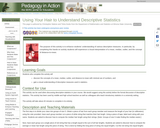
Think-Pair-Share activities pose a question to students that they must consider alone and then discuss with a neighbor before settling on a final answer. This is a great way to motivate students and promote higher-level thinking. Even though the activity is called think-"PAIR"-share, this is the term many instructors use for pairs and small groups (three or four students) alike. Groups may be formed formally or informally. Often this group discussion "sharing" is followed up with a larger classroom discussion. Some think-pair-share activities are short, "quick-response think-pair-share" and sometimes the activities may be longer and more involved, "extended think-pair-share." The instructor can use the student responses as a basis for discussion, to motivate a lecture segment, and to obtain feedback about what students know or are thinking and it is easy to incorporate more than one think-pair-share activity in a given class period.
- Subject:
- Education
- Material Type:
- Teaching/Learning Strategy
- Provider:
- Science Education Resource Center (SERC) at Carleton College
- Date Added:
- 09/11/2023
